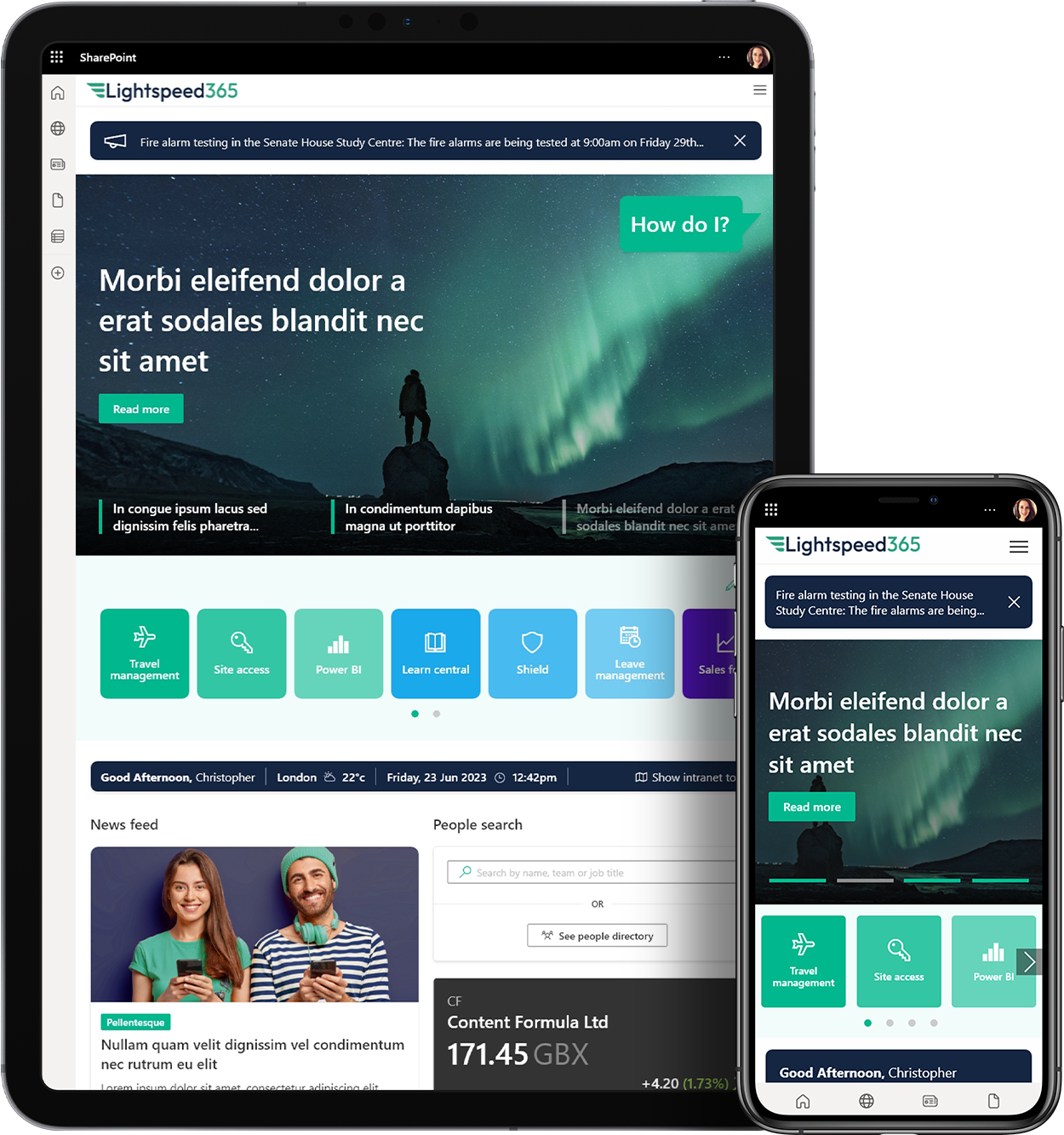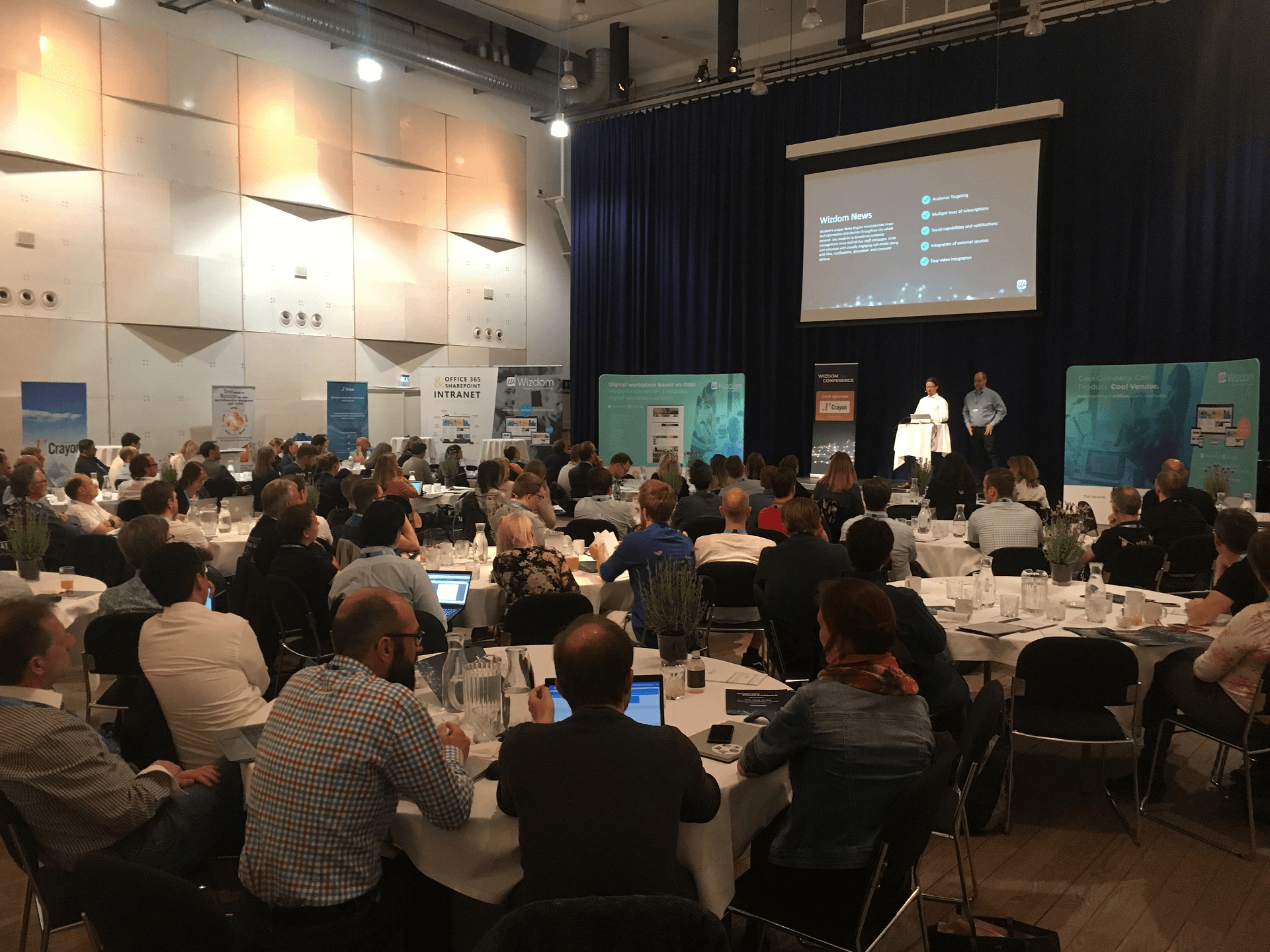Day two of the Wizdom Conference saw another very sunny day at Copenhagens historic Tivoli Gardens. Delegates arrived energised and excited (despite the wine flowing freely on the previous evening), ready for another full day of presentations about the digital workplace.
Wizdoms CEO John Wainer opened the day by welcoming everybody and mentioning some of his takeaways from day one. He also reminded us that the conference was all about taking some inspiration home with you, so you could use it within your own digital workplace.
And it did prove to be inspiring with some interesting case studies, practical tips and insightful observations about the digital workplace. Here are some of the main themes from day two which stood out for us.
The digital workplace has outgrown the confines of the traditional intranet
At Wizdom we love intranets (and we always will!) but were also excited by the future possibilities of the digital workplace. Many companies are using the intranet as the front door to the digital workplace and the Office 365 universe, but several of the case studies at the Conference show how the digital workplace is starting to outgrow the confines of the traditional intranet.
Its also a trend which is reflected in the future developments of the Wizdom product, all of which reflect the feedback and request we receive from our clients. The opening session of the day, a joint keynote from Jess Lassen, Wizdoms CTO and Flemming Goldbach, our Vice President of Product, was titled The digital workplace of the future in a Microsoft universe and covered the principles which inform Wizdoms product roadmap. We also got to see sneak previews of some of the cool features in the pipeline.
While many of these new improvements and capabilities focus on the intranet such as better content targeting, support for multi-language intranets and even nudges and suggestions for content owners, there were a number which expanded access to the digital workplace beyond the intranet. One of these is a new Wizdom mobile app with a beautiful user experience and expansive capabilities, ensuring work can be done from anywhere. The app features access to news, the phonebook, links and has Yammer integration. There is also the ability to create mobile-specific pages which can be targeted, for example, to employees in the field.
There is also an exciting Power Panel which is a toolbar which can be accessed not only from within the Wizdom intranet but also other parts of SharePoint, the Office 365 and even potentially the wider Microsoft universe. The Power Panel can be configured by each client to meet their needs and allows you to access and create pages and content, get relevant links to critical services and navigate around. It is extremely powerful as it can be targeted to different users and even be contextual, based on where it is being accessed from. The Power Panel also has an in-built bot who can make suggestions and nudge users into actions. It was clear from the demo that it will be both a gateway and a digital assistant which surfaces the wider digital workplace from anywhere.
The best digital workplaces place the user at the centre
A principle which also informs everything that Wizdom builds is to put the user at the centre of the digital workplace. We know what we build must provide value or users will just simply go elsewhere and use a different tool. The best digital workplace implementations weve seen also follow this principle.
At the Conference we had a strong presentation from Mads Boldsen, Lead Business Consultant, Ørsted A/S. Ørsted is a Danish energy company committed to green energy that recently has gone through a period of intense change with a new name and identity. There is also a brand new digital workplace. What was very challenging for the project was that it was already underway once the decision to re-brand the company had been made, and the project team had to navigate the issue of keeping this confidential while also working closely with users to ensure the digital workplace met their needs.
Whats fantastic about Ørsteds digital workplace is that it is truly centred around user needs and daily work. This has been achieved through extensive user research and testing, delivering an intuitive information architecture and an approach to content migration with the deletion of many pages which were not delivering value to users.
The team also carried out a very detailed user satisfaction survey both before and after the new environment was delivered. Perhaps surprisingly the feedback was similar across both surveys but given the scale of changes in the company (and change can be difficult) it was actually a positive trend and gives insight into future improvements to make. At its heart the digital workplace implementation was community-driven project, and the result is a community-driven digital workplace.
Another organisation that created a highly user-centric digital workplace was GEA Group, a German technology company with 17,000 employees. In a joint session from Christian Larsen, Director of Internal Communication & Corporate Events, and Claus Ole Hasle, Wizdoms COO, we heard how GEA has created a task-based intranet which is driven by a solid understanding of user and stakeholder needs. Successful approaches included taking time to truly understand the tasks employees need to complete and finding the right content to meet these needs. The team also conducted extensive user testing of their information architecture and refined it accordingly ensuring strong usability. Christians point that user testing creates buy-in, saves time, removes the emotion from decision-making and forges better results was spot on.
Successful digital workplaces focus on collaboration and productivity
Two of day twos case studies reminded us how the digital workplace must make collaborating that bit easier for employees and start to unlock productivity and efficiency.
We had a very interesting session from Ute Aggensteiner, Project Manager for Intranet & SharePoint at Stadtwerke Lübeck Holding GmbH and Torsten Schlueter, HanseVision, GmbH. Stadtwerke Lübeck Holdings award-winning digital workplace project has three main components Information & Communication, Collaboration and Workflow & Digitalization. With a complex organisational structure and many employees who dont sit at desks this is a considerable challenge. The team has made significant process in using workflow and forms to digitize 88 processes and integrate these into the intranet, resulting in significant ROI.
The team has also given employees the power to collaborate both internally and externally and has made this much easier by creating a compelling collaboration area which listed relevant sites for each user, as well as aggregating tasks and documents from each workspace. They also created site templates for different use cases such as sharing documents externally or running more complex projects. This was a true digital workplace which exposed employees to a range of different tools.
Ramboll, a global engineering and design consultancy headquartered in Denmark, is also bringing collaboration to the centre of its new digital workplace. Poul Hededal, Group Director, Knowledge & Innovation at Ramboll told us the story of the new digital workplace which includes several different components.
As well as compelling new global intranet (brilliantly named Rambla) there is also an expansive and ambitious project portal. Poul explained how Ramboll is a very project-orientated company and has a staggering 40,000 projects ongoing at any one time with a dedicated project space for both very small and absolutely massive projects and all in-between. The project portal aims to make these spaces more efficient and accessible for employees, integrate information from other systems, and will help to fulfil the teams vision:
to create an integrated digital environment, Digital Workspace, that allows employees to communicate, collaborate and deliver excellence, whenever and wherever they may be working.
From this the digital workplace aims to become a transformational lever and change the way people work.
Office 365 has a range of excellent collaboration, productivity and project management tools on offer, but sometimes a more engaging interface or approach is needed to help drive adoption and bring these tools into the everyday flow of work. Both these case studies show how integrating information from other systems and creating a central portal that aggregates data can provide real value for employees and organisations.
Digital workplaces must continuously improve
Everyone in the world of intranets and digital workplaces knows that they are never truly finished. There is always more work to do on then. Continuous improvement, working on driving adoption and change management are a must.
This is a theme which perhaps permeated almost every presentation on day two. Paul Linde, Founder, Mindfire AB, gave an interesting presentation about some of the trends he was seeing in the digital workplace. He talked us how intranets had evolved from being megaphones for management to take in formal collaboration and then more social capabilities. User needs have also evolved significantly, but a key to getting success out of the digital workplace is to ensure there is good adoption. Paul ran us through several approaches including the importance of continuous improvement.
Many of the case studies were also investing in driving adoption and improving just after launch and beyond. At GEA Group there was an organised programme of after-project governance and maintenance. At Stadtwerke Lübeck the team continue to add processes to their digitalization programme. Many of the features of Rambolls digital workplace are still very new and will continue to evolve. And Ørsted are finding out their views of their users to improve the digital workplace. Each had also invested heavily in communication and engagement, running road-shows, producing attractive marketing, making videos and using champions and gamification to inform and engage users as seen with Implement Consulting Group.
Of course, continuous improvement is also an important part of the way Wizdom works. We are always adding new features, listening to our clients and making the digital workplace work better.
Its been an excellent conference
Weve had a truly excellent conference. The venue was great, the speakers were illuminating, and the attendees provided us with lively debate and feedback. We hope everybody learnt something, made new connections and friends and also thoroughly enjoyed the two days. We know we did and were already looking forward to next year. See you then!
The original article was published here



 SharePoint Products
SharePoint Products


